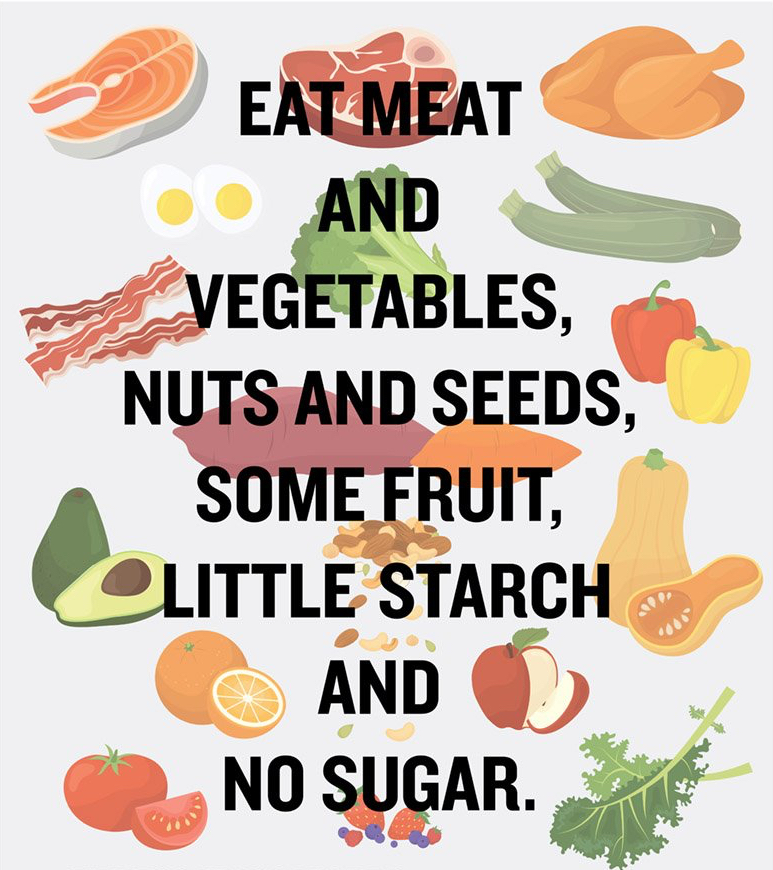Welcome to the CrossFit Spur Blog!
I spent a lot of time contemplating what the best first post on the Spur Blog would be. While I’ve written down a ton of notes on various topics it occurred to me that the best topic was right in front of me. In fact, you probably walk by it every time you’re at Spur.
Between the bathrooms hangs a poster titled “Fitness In 100 Words”.
This poster outlines the essence of CrossFit methodology and while I’m sure many have read it, it’s likely few have given further thought to the meaning.
In this three part blog post I’ll outline the major components of this poster in order of importance, as they’re written.

Part 1: NUTRITION
“Eat meat and vegetables, nuts and seeds, some fruit, little starch and NO SUGAR. Keep intake to levels that will support exercise but not body fat.”
There’s one simple reason Greg Glassman started his definition of fitness with nutrition.
It’s the most important.
Nutrition today is a tricky subject as there’s a seemingly endless stream of information available right at our fingertips.
Who should you believe? What foods are good? What foods are bad? What diet is best?
Nutrition doesn’t have to be that complicated. When it comes to nutrition most people are unsuccessful because they overlook the first step in their quest for the “perfect nutrition plan”.
A good analogy would be the athlete who desperately wants a bar muscle up but can’t perform a single strict pull up. Nor do they focus on acquiring that strict pull up first. Instead, they search for gymnastics programs and muscle up skill progressions all the while ignoring the first (and most important) step.
Searching for the right macro ratio or determining the ideal time for intermittent fasting may result in a temporary change, however without the first step it won’t be sustainable.
Stop. Eating. Junk.
Unless everything you eat fits within the parameters of that first sentence, you’ve got some work to do.
Things like cleanses, fasting, calorie restriction, etc may work for some and not others, but none of them provide lasting results. They’re unpredictable and unsustainable because they skip the first step. They have selling power because they provide a quick fix, but are only backed by anecdotal evidence; “Learn how this tik-tok influencer lost 50lbs in 30 days!”
The impact of eating REAL food is predictable. It’s backed by a plethora of scientific evidence as well as hundreds of thousands of years of proven success via human survival.
Step 1: Clean It Up.
The first step is to start eating real food. You can’t jump in full speed ahead or it will surely result in failure. Instead let’s set a goal of 5 days per week. Out of 7 days that’s 71.4%, or a C- effort, which is realistic starting point.
“Eat Meat and Vegetables.”
Not Meat:
- Processed cold cuts (deli meat)
- Impossible burgers / soy based “meat”
- Hot dogs
- Fish sticks
- Chicken nuggets
* Anything that has an ingredients list longer than one word isn’t meat!
Not Vegetables:
- Beans (see: “Little Starch” below)
- Corn (see: “Little Starch” below)
- V8 or vegetable juice
- Vegetable oils
- Vegetable vitamin supplements (ex: Balance of Nature)
* Again, if it has an ingredients list longer than one word it’s not a vegetable
“Nuts and Seeds.”
Not Nuts:
- Honey roasted, chocolate covered, candy coated, etc… These are candy.
- Nut butters (unless the only ingredient is the nut itself and salt)
- Peanuts – technically it’s a legume, but I personally don’t see a problem with peanuts
- Bread / baked goods made with nut flours
Not Seeds:
- Seed crackers
- Bread /baked goods made with seed flours
- Seed oils
“Some Fruit, Little Starch and NO SUGAR.”
I personally don’t limit fruit intake. Things such as berries and melon have relatively low carbohydrate (sugar) content, are loaded with vitamins and minerals. Plus, they’re delicious.
While many will argue fruit is high in sugar and should be limited, I’d argue that I’ve never seen or heard of a person becoming overweight or unhealthy from eating too much fruit. Eat the fruit.
“Little Starch” — Don’t have it at every meal. My main starchy foods are potatoes, yucca, rice, beans, corn and squash.
Not Fruit:
- Fruit snacks
- Fruit juice (yes, even if it says “100% fruit juice” – it’s not fruit)
- Fruit jelly / jam / marmalade
- Fruit Smoothies
Not Starch:
- Potato chips
- Baked vegetable chips / snacks
- Rice cakes
- Pop corn
- Baked goods / bread
“NO SUGAR.” This is referring to ADDED or processed sugar, which is in everything. Start reading labels. Look for options with no added sugars and no artificial sweeteners. You’ll be surprised how many foods contain added sugar once you start looking for it.
I know breaking habits isn’t an easy task, but if you adhere to the list above the changes you’ll experience are well worth the effort. Stick with it and give it some time.
Key Takeaways:
- The majority of your food should be single ingredient (stick to the list)
- Don’t worry about macros or micros or meal timing until most of the food you eat is real food (see poster below)
- Spices are your friend – simply adding salt, pepper and garlic will take your meal from bland to savory.
- Read labels – understand what you’re putting in your body.
- Eat when you’re hungry, not when you’re bored.

